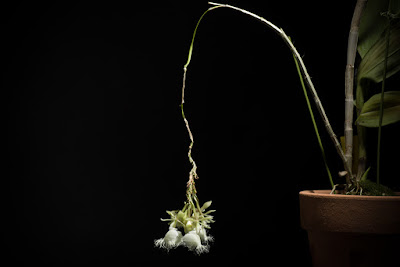Epidendrum ilense is native to Ecuador. Their natural habitat is narrowed to a small region in the Pinchincha Province, on the western side of the Andes foot.
Epidendrum ilense also called as The Ila Epidendrum (named after the Mountains in Ecuador), is a species of the genus Epidendrum. This species was described by Dodson in 1977.
IDENTIFY EPIDENDRUM ILENSE
Epidendrum ilense is native to Ecuador. Their natural habitat is narrowed to a small region in the Pinchincha Province, on the western side of the Andes foot. These plants were harvested just to the south of the equator, at the southern end of Monta-as de Ila, where they grew epiphytically in a very humid forest at an altitude of about 540 m.
It is a medium sized, hot growing terrestrial or epiphyte, which reaching 50 cm in height, with simple, cane-like, laterally compressed, suberect, tall, slender, 50 cm long stems enveloped by tubular sheaths and forming keikis in the apical half carrying several pairs (13 to 18) of distichous, all along the stem, alternate, articulate, narrrowly elliptic, acute, minutely apiculate, basally clasping, margin entire, 13 cm long and 3.3 cm wide leaves.
The Ila Epidendrum blooms throughout the year on a terminal, pendant, 12" (30 cm) long, few flowered racemose inflorescence with much shorter than the ovary, triangular, acuminate, amplexicaul floral bracts and carrying 3 to 7, simultaneously opening flowers produced successively over the years. When the first ones die, a new group of 4 flowers grows from a node closer to the top of the inflorescence and this process lasts until reaching the apex of the shoot. In the end, a bunch of flowers is formed in knots below the leaves on the last mature shoot and in the nodes on shoots from previous years. This makes the plant thrive, especially when it is a mature, well-run plant.
The flowers are about 2.5 cm in diameter with wide-spread side petals. The white flakes of the outer whorl are large and widely distributed, and the slightly smaller flakes of the inner whorl are directed forward at an angle on both sides of the spine. The base of the lip is fused with the prone on the greater part of the length of the spine. The lip is white, large, oval, with strongly fringed edges. The fringe can sometimes be longer than the lip itself.
EPIDENDRUM ILENSE CARE AND CULTURE
Cultural information should only be used as a guide, and should be to be adapted to suit you. Your physical location; where you grow your plants, how much time you have to devote to their care, and many other factors, will need to be taken into account. Only then can you decide on the cultural methods that best suit you and your plants.
Light:
Epidendrum ilense needs a light level of 25000-35000 lux. The light should be slightly filtered or dispersed, and the plants should not be exposed to the direct sunlight of the midday sun. Strong air movement should be ensured all the time.
Temperature:
Throughout the year, the average day temperature is 26-27 ° C, the night 17-19 ° C, and the daily difference is 8-9 ° C.
Humidity:
The Ila Epidendrum needs the humidity of 75-80% throughout the year.
Substrate, growing media and repotting:
Epidendrum ilense need good drainage, so they are usually grown in pots or baskets filled with a thick, loose, quickly drying ground that allows quick root drying after watering. It is better to use small pots, sufficient for 1-2 years of growth, because the substrate in large pots is too wet for too long. If the roots do not dry out quickly after watering, they may rot. Most often, a substrate is used based on bark of medium granulation, but a mixture of chopped woody fern fibers and cut sphagnum moss is also suitable.
If this orchid grows on the block, it is necessary to create a high humidity for it and water it at least once a day in the summer. In hot and dry weather, you may need to water multiple times during the day.
Repotting or dividing should be done only when new roots begin to grow, because then the plants will stabilize faster and without stress.
Watering:
Precipitation is small to moderate throughout the year, with a long period of drought lasting from autumn until the following spring. Epidendrum ilense should often be watered during active growth, but excellent drainage should be ensured, and the ground around the roots can never be soggy or damp.
Fertilizer:
During the growing season it is recommended to feed the plant 1/4-1/2 weekly fertilizer doses for orchids. From spring to mid-summer, a fertilizer with a high nitrogen content is useful, and then it is better to use a fertilizer with a high content of phosphorus before the end of autumn.
Rest period:
In winter, however, the amount of water should be slightly reduced, especially when Epidendrum ilense are grow under conditions of a short, dark day at moderate latitudes. The plants should dry a little between watering, but they can never stay dry for too long. If the amount of water decreases, also reduce fertilization.















COMMENTS